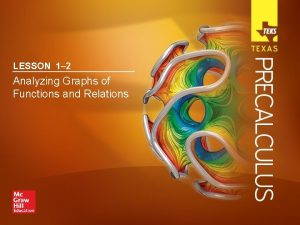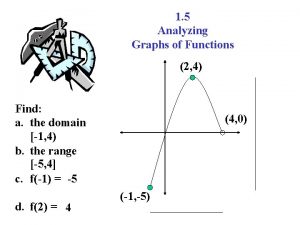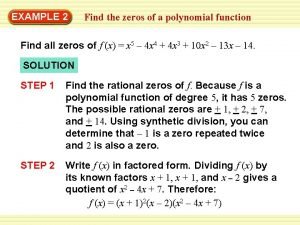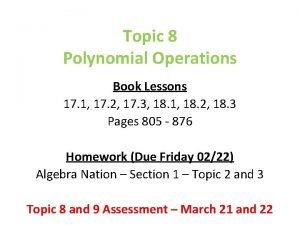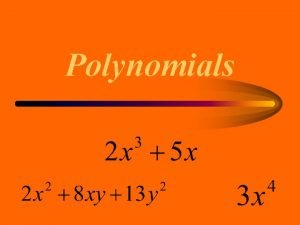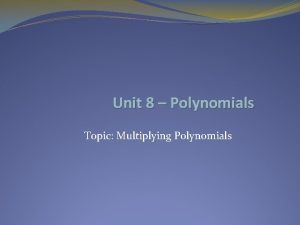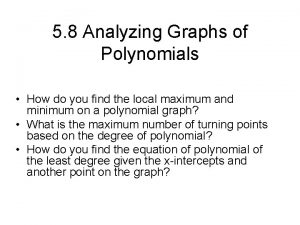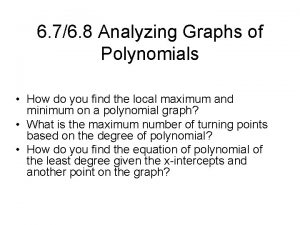Analyzing Graphs of Polynomials Section 3 2 First














- Slides: 14

Analyzing Graphs of Polynomials Section 3. 2

First a little review… Given the polynomial function of the form: If k is a zero, x = k Zero: _____ x = k Solution: _____ (x – k) Factor: _____ x - intercept If k is a real number, then k is also a(n) _________.

What kind of curve? All polynomials have graphs that are smooth continuous curves. A smooth curve is a curve that does not have sharp corners. Sharp corner – This graph must not be a polynomial function. A continuous curve is a curve that does not have a break or hole. Hole Break This is not a continuous curve!

End Behavior An > 0 , Odd Degree (Think of a line with positive slope!) An < 0 , Odd Degree (Think of a line with negative slope!) y y x An > 0 , Even Degree (Think of a parabola graph… y = x 2. ) An < 0 , Even Degree (Think of a parabola graph… y = -x 2. ) y y x x x As x - , f(x) As x + , f(x)

Examples of End Behaviors 1. 2. 3. 4.

What happens in the middle? The Re gra lati ph ve ma xi “tur n s” mu ** This graph is said to have m 3 turning points. ** The turning points happen when the graph changes direction. This happens at the vertices. ** Vertices are minimums and maximums. s um e m ini m tiv a l e R e Th gr h ap “t ” ns r u ** The lowest degree of a polynomial is (# turning points + 1). So, the lowest degree of this polynomial is 4!

What’s happening? Relative Maximums Relative Minimums As x - , f(x) As x + , f(x) 4. The number of turning points is _____ The lowest degree of this polynomial is _____ 5. positive The leading coefficient is _____.

Graphing by hand Step 1: Plot the x-intercepts Step 2: End Behavior? Number of Turning Points? Step 3: Check in Calculator!!! Example #1: Graph the function: and identify the following. , f(x) Negative-odd polynomial of degree 3 ( -x * x) f(x) = -(x + 4)(x + 2)(x - 3) As x + , f(x) As x End Behavior: _____________ 3 Lowest Degree of polynomial: _______ 2 # Turning Points: ____________ You can check on your calculator!! x-intercepts

Graphing with a calculator Example #2: Graph the function: and identify the following. f(x) = x 4 – 4 x 3 – x 2 + 12 x – 2 , f(x) As x + As x - , f(x) End Behavior: _____________ 4 Degree of polynomial: _______ 3 # Turning Points: ____________ (0, -2) y-intercept: _______ Relative max 1. Plug equation into y= Real Zeros 2. Find minimums and maximums using your calculator Relative minimum Absolute minimum Positive-even polynomial of degree 4

Graphing without a calculator Example #3: Graph the function: and identify the following. As x - f(x) = x 3 + 3 x 2 – 4 x , f(x) As x + End Behavior: _____________ 3 Degree of polynomial: _______ 2 # Turning Points: ____________ 1. Factor and solve equation to find x-intercepts f(x)=x(x 2 + 3 x – 4) = x(x - 4)(x + 1) 2. Plot the zeros. Sketch the end behaviors. Positive-odd polynomial of degree 3

Zero Location Theorem Given a function, P(x) and a & b are real numbers. If P(a) and P(b) have opposite signs, then there is at least one real number c between a and b such that P(c) = 0. a b P(b) is positive. (The y-value is positive. ) Therefore, there must be at least P(a) is negative. (The y-value is negative. ) one real zero in between x = a & x = b! Example #4: Use the Zero Location Theorem to verify that P(x) = 4 x 3 - x 2 – 6 x + 1 has a zero between a = 0 and b = 1. The graph of P(x) is continuous because P(x) is a polynomial function. 0 4 -1 -6 1 0 0 0 4 -1 -6 1 1 4 -1 -6 1 4 3 -3 -2 P(0)= 1 and P(1) = -2 Furthermore, -2 < 0 < 1 The Zero Location Theorem indicates there is a real zero between 0 and 1!

Polynomial Functions: Real Zeros, Graphs, and Factors (x – c) • If P is a polynomial function and c is a real root, then each of the following is equivalent. is a factor of P • (x – c) _________________. • x=c is a real solution of P(x) = 0 _________________. • x=c is a real zero of P _________________. an x-intercept of the graph of y = P(x). • (c, 0) is _________________

Even & Odd Powers of (x – c) The exponent of the factor tells if that zero crosses over the x-axis or is a vertex. If the exponent of the factor is ODD, then the graph CROSSES the x-axis. If the exponent of the factor is EVEN, then the zero is a VERTEX. Try it. Graph y = (x + 3)(x – 4)2 Try it. Graph y = (x + 6)4 (x + 3)3

Assignment: Write the questions and show all work for each. pp. 301 -302 #1 -13 ODD, 17 & 19 (TI-83), 21 -29 ODD, 33, 35, 41, & 43
 Lesson 1 analyzing a graph
Lesson 1 analyzing a graph Analyzing graphs of functions and relations
Analyzing graphs of functions and relations Analyzing graphs of functions
Analyzing graphs of functions 5-4 analyzing graphs of polynomial functions
5-4 analyzing graphs of polynomial functions Polynomial functions and their graphs
Polynomial functions and their graphs A sort of sorts analyzing and sorting graphs
A sort of sorts analyzing and sorting graphs Analyzing graphs of functions
Analyzing graphs of functions 5-4 practice analyzing graphs of polynomial functions
5-4 practice analyzing graphs of polynomial functions What is state graph in software testing
What is state graph in software testing Speed and velocity
Speed and velocity Graphs that enlighten and graphs that deceive
Graphs that enlighten and graphs that deceive 5-3 practice polynomial functions
5-3 practice polynomial functions Section 3 analyzing production possibilities answers
Section 3 analyzing production possibilities answers Section 1 topic 8 operations with polynomials
Section 1 topic 8 operations with polynomials Section 3 communicating with graphs answer key
Section 3 communicating with graphs answer key
